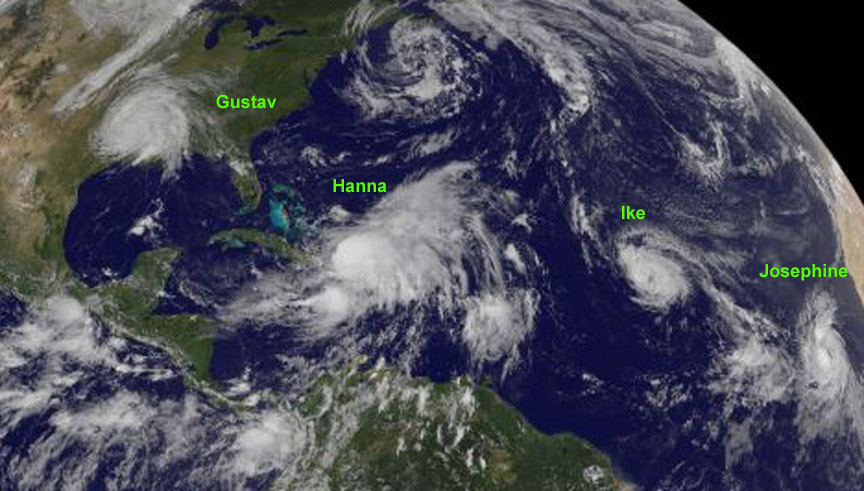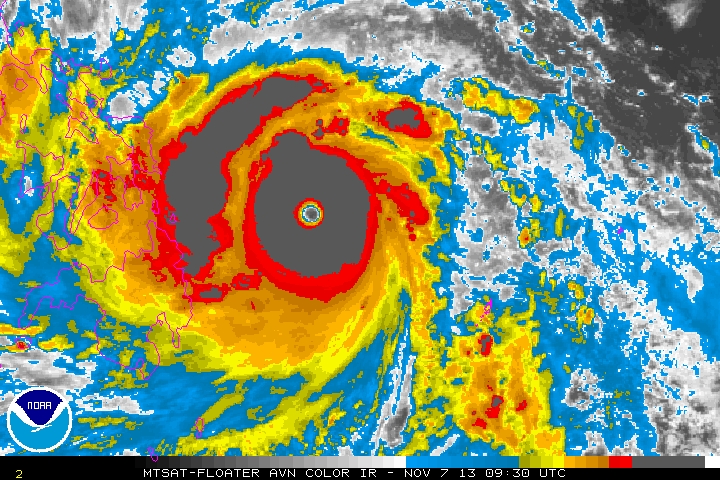Prioritize...
When you've completed this page, you should be able to describe how tropical cyclones are named in the Atlantic and Northeast Pacific Basins, and use a storm's name to draw conclusions about how many named storms have occurred in a given season.
Read...
Katrina. Sandy. Harvey. Irma. Maria, Michael. Do any of these names ring a bell? They're all names of devastating hurricanes that have ravaged parts of the United States since 2005. The names of impactful tropical cyclones often become forever linked to the death and destruction that a storm causes, and for some folks, these names may conjure up memories of personal hardships.
It turns out that the convention for naming tropical cyclones has quite a long (and in some cases, humorous) history, and each ocean basin has its own unique history of naming tropical cyclones. In the Atlantic, the earliest practice of naming Atlantic hurricanes goes back a few hundred years to the West Indies. Indeed, islanders named hurricanes after saints (when hurricanes arrived on a saint's day, locals christened the storm with the name of that saint). For example, fierce Hurricane Santa Ana struck Puerto Rico on July 26, 1825, and Hurricane San Felipe (the first) and Hurricane San Felipe (the second) hit Puerto Rico on September 13, 1876 and September 13, 1928, respectively.
During World War II, Navy and Army Corp forecasters informally named Pacific storms after their girlfriends or wives (who may not have been happy if they had known). That apparently started the ball rolling in the United States. From 1950 to 1952, meteorologists named tropical cyclones in the North Atlantic Ocean according to the phonetic alphabet (Able, Baker, Charlie, etc.). Then, in 1953, the U.S. Weather Bureau switched the list to female names. In 1979, the World Meteorological Organization and the National Weather Service (NWS) amended their lists to also include male names.
Conventions developed differently in other parts of the world. For example, an Australian forecaster named Clement Wragge began to name tropical cyclones after politicians he disliked just before the start of the nineteenth century. Forecasters in the Australian and South Pacific regions (east of longitude 90 degrees East, and south of the equator) formally started to christen tropical storms with female names in 1964. They beat the United States to the punch and began to use both male and female names in the mid 1970s.
Despite the checkerboard history behind the naming of tropical cyclones in the various basins around the world, the reason why tropical cyclones get named is pretty straightforward. The practice of naming tropical cyclones ensures clear, unambiguous communication between forecasters and the general public when forecasts, watches, and warnings are issued. At any given time across the globe (or even within a single tropical basin) there can be multiple tropical cyclones present at any one time. For example, the satellite image from September 2, 2008 (below) shows a whopping four named storms present in the Atlantic Basin!

Without the practice of naming tropical storms, deciphering forecasts with four active storms in the basin could have been a real mess -- sifting through coordinates or other technical descriptions of a storm's location. In the end, using names is much simpler for the general public, so let's get to the business of how storms are named. For starters, before reaching tropical-storm intensity, a tropical depression in the Atlantic or Northeast Pacific simply gets assigned a number in chronological order (so the first tropical depression in a season is known as "Tropical Depression 1," the second is known as "Tropical Depression 2," etc.). For storms that reach tropical-storm intensity in the Atlantic and Northeast Pacific, the World Meteorological Organization and National Weather Service (NWS) have used lists of alternating male and female names in alphabetical order to christen storms since 1979. Here are the lists currently in use. Note that each basin has six alphabetized lists of names, which get reused (so the list of names for 2023 was previously used in 2017, for example).
The exception is when a particular tropical storm or hurricane is especially damaging or deadly. Such storms have their names retired from the list, never to be used again. When a name gets retired, the World Meteorological Organization chooses a new name as a replacement. For example, the names Harvey, Irma, Maria, and Nate from the 2017 list were retired and replaced with Harold, Idalia, Margot, and Nigel (respectively) for the 2023 season. It's fairly typical for a couple of names to get retired each year. The four name retirements from the 2017 Atlantic Hurricane season is a lot for a single year, and is a testament to the destructiveness of the season.
So, each year, the first tropical storm gets a name starting with "A," then the second tropical storm gets a name starting with "B", the third gets a name starting with "C", and so on (although the letters Q, U, X, Y, and Z are skipped). I should point out that any year that the alphabetical list of male and female names is not long enough to accommodate all the named storms in a season, the National Hurricane Center turns to a supplemental list of names; however, prior to 2021, the standard was to use letters of the Greek Alphabet (Alpha, Beta, Gamma, Delta, etc.) to name storms once the original list of names had been exhausted. Use of the Greek Alphabet to name storms only occurred twice (2005 and 2020).
The name game is a bit more complicated in other ocean basins. In the Northwest Pacific, for example, since the year 2000, the World Meteorological Organization has used names which are, for the most part, not male or female names. Instead, most names on the list refer to flowers, animals, birds, trees, or even foods, etc. Others are simply descriptive adjectives. Each name on the list is contributed by a participating nation within the basin. The names are not used in alphabetical order like in the Atlantic and Eastern Pacific, however. Instead, the contributing nations are listed in alphabetical order and this ranking determines the order that the names are assigned.

It's important to note, however, that the established lists from the World Meteorological Organization are not universally used for storms in the Northwest Pacific. The Philippine Atmospheric, Geophysical and Astronomical Services Administration (PAGASA) assigns Filipino words as storm names when storms threaten the Philippines so that locals can easily remember them and communicate about the storm. For example, in November 2013 Super Typhoon Haiyan made landfall in the Philippines as one of the strongest tropical cyclones on record at the time of landfall. But, in the Philippines, Haiyan (which is from the Chinese for "petrel" -- a type of seabird) was known as "Yolanda." So, tropical cyclones in the Northwest Pacific basin can actually have two valid names at once.
If you want to see the lists of names for tropical cyclones in all tropical basins (including the North Indian Ocean and other basins not covered here), check out the World Meteorological Organization's page of tropical cyclone names. While the naming conventions can get a bit complicated in some basins, they're pretty straightforward in the Atlantic and Northeast Pacific basins. Make sure to remember the key points below about the naming conventions in these basins.
Key Points
In the Atlantic and Northeast Pacific Basins...
- tropical cyclones receive a name when they attain tropical-storm intensity (sustained winds of 34 to 63 knots, or 39 to 73 miles per hour)
- names are assigned in alphabetical order from a list of alternating male and female names (the first tropical storm of the season gets the "A" name, the second gets the "B" name, and so on)
- if the season is so active that the alphabetical list of male and female names isn't long enough, forecasters use a supplemental list of names (although they used the Greek Alphabet prior to 2021)
- names of particularly damaging or deadly storms get retired, never to be used again. The World Meteorological Organization replaces retired names on the list
Now that we've covered what tropical cyclones are, where, when, and why they form, and how they get named, let's start looking at just how they develop. What ingredients are needed for tropical cyclone development? We'll start answering that question in the next section. Read on.